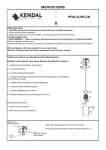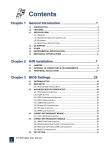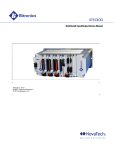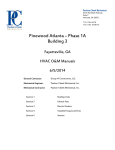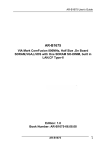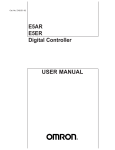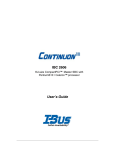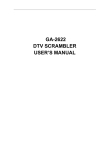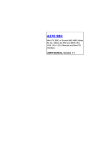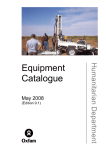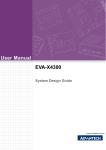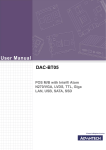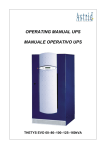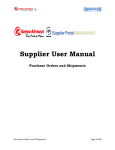Download RIO-3302/RIO-3302S 6U CompactPCI TM Rear Transition card
Transcript
RIO-3302/RIO-3302S 6U CompactPCI TM Rear Transition card Copyright Notice This document is copyrighted, 2001. All rights are reserved. The original manufacturer reserves the right to make improvements to the products described in this manual at any time without notice. No part of this manual may be reproduced, copied, translated or transmitted in any form or by any means without the prior written permission of the original manufacturer. Information provided in this manual is intended to be accurate and reliable. However, the original manufacturer assumes no responsibility for its use, nor for any infringements upon the rights of third parties which may result from its use. Acknowledgements PICMG™, CompactPCI™ and the PICMG™, CompactPCI™ logos are trademarks of the PCI Industrial Computers Manufacturers Group All other product names or trademarks are properties of their respective owners. CE Notification The MIC-3036, developed by Advantech Co., Ltd., has passed the CE test for environment specifications when shielded cables are used for external wiring. We recommend the use of shielded cables. Part No. 2002330200 Printed in Taiwan 1st Edition October 2001 Preface and Table of Contents Product warranty Advantech warrants to you, the original purchaser, that each of its products will be free from defects in materials and workmanship for one year from the date of purchase. This warranty does not apply to any products which have been repaired or altered by persons other than repair personnel authorized by Advantech, or which have been subject to misuse, abuse, accident or improper installation. Advantech assumes no liability under the terms of this warranty as a consequence of such events. Because of Advantech’s high quality-control standards and rigorous testing, most of our customers never need to use our repair service. If an Advantech product is defective, it will be repaired or replaced at no charge during the warranty period. For out-of-warranty repairs, you will be billed according to the cost of replacement materials, service time and freight. Please consult your dealer for more details. If you think you have a defective product, follow these steps: 1. Collect all the information about the problem encountered. For example, CPU speed, Advantech products used, other hardware and software used, etc. Note anything abnormal and list any onscreen messages you get when the problem occurs. 2. Call your dealer and describe the problem. Please have your manual, product, and any helpful information readily available. 3. If your product is diagnosed as defective, obtain an RMA (return merchandise authorization) number from your dealer. This allows us to process your return more quickly. 4. Carefully pack the defective product, a fully-completed Repair and Replacement Order Card and a photocopy proof of purchase date (such as your sales receipt) in a shippable container. A product returned without proof of the purchase date is not eligible for warranty service. 5. Write the RMA number visibly on the outside of the package and ship it prepaid to your dealer. RIO-3302/RIO-3302S User's Manual Packing List Before installation, ensure that the following materials have been received: • One RIO-3302 (or RIO-3302S) CompactPCI™ rear transition card • One warranty certificate • One startup Manual • One CD disc and manual (in PDF format) If any of these items are missing or damaged, contact your distributor or sales representative immediately. Technical Support and Sales Assistance If you have any technical questions about the RIO-3302 (or RIO-3302S) or any other Advantech products, please visit our support website at: • http://www.advantech.com.tw/support For more information about Advantech's products and sales information, please visit: • http://www.advantech.com Preface and Table of Contents Contents 1. General Information ..................................... 1 1.1 Introduction ................................................................................. 2 1.2 Specification ................................................................................ 2 1.2.1 SCSI Function ................................................................................. 2 1.2.2 Standard functions .......................................................................... 2 1.2.3 Mechanical and environmental specifications ................................ 3 1.3. Indicator and Connector Location ................................................. 4 2. Hardware and drivers Installation .............. 7 2.1 Card installation .......................................................................... 8 2.1.1 2.1.2 Card Installation and Removal ..................................................... 8 Driver installation ...................................................................... 10 A. Pin Assignments ........................................ 11 A.1 J1 connector pin assignment (RIO-3302S only) ...................... 12 A.2 J2 connector pin assignment (RIO-3302S only) ...................... 13 A.3 Pin Assignment ........................................................................ 14 A.3.1 J3 Connector Pin Assignment ..................................................... 14 A.3.2 J4 Connector Pin Assignment ..................................................... 15 A.4 RIO-3302S Ultra3 SCSI Connectors (CN50) ........................... 16 A.5 VGA Display Connector (CN1) ................................................. 18 A.6 Keyboard and Mouse Connnector (CN8,CN9) .......................... 18 A.7 COM1 and COM2 Serial Port (CN12, CN6) ............................. 19 A.8 USB Connector (CN3) ............................................................... 20 A.9 Ethernet RJ-45 Connector (CN2,CN4) ..................................... 20 A.10 CompactFlash Socket (CN14) ................................................... 21 A.11 Floppy Disk Drive Connector (CN7) ......................................... 22 RIO-3302/RIO-3302S User's Manual A.12 Hard Disk Drive Connector (CN11,CN13) ............................... 23 A.13 Hard Disk Drive Connector (CN10) ......................................... 24 Preface and Table of Contents Figures Figure 1-1: RIO-3302/RIO-3302S connector and jumper locations ............... 4 Figure 2-1: Installing a card into the chassis ................................................ 9 RIO-3302/RIO-3302S User's Manual Tables Table 1-1: RIO-3302/RIO-3302S connector and jumper descriptions ........... 5 Table A-1: J1 connector pin assignments .................................................... 12 Table A-2: J2 connector pin assignments .................................................... 13 Table A-3: J3 Connector Pin Assignment ..................................................... 14 Table A-4: J4 Connector Pin Assignment ..................................................... 15 Table A-5: RIO-3302S Ultra3 SCSI connectors ............................................ 16 Table A-6: RIO-3302/RIO-3302S CRT display connector ............................. 18 Table A-7: RIO-3302/RIO-3302S keyboard and mouse connector .............. 18 Table A-8: RIO-3302/RIO-3302S COM1 and COM2 serial port .................... 19 Table A-9: RIO-3302/RIO-3302S USB1 connector ....................................... 20 Table A-10: RIO-3302/RIO-3302S Ethernet RJ-45 connector ...................... 20 Table A-11: RIO-3302/RIO-3302S CompactFlash socket ............................ 21 Table A-12: Floppy Disk Drive Connector ..................................................... 22 Table A-13: Hard Disk Drive Connector ........................................................ 23 Table A-14: Hard Disk Drive Connector ........................................................ 24 Preface and Table of Contents CHAPTER 1 General Information Chapter 1 General Information 1 1.1 Introduction The RIO-3302/RIO-3302S is a CompactPCI 6U-sized rear transition board. It provides access to the rear panel for the I/O function on Advantech’s CompactPCI CPU board. 1.2 Specification 1.2.1 SCSI Function • Controller : Adaptec AIC-7892TM • Bus : PCI 64-bit / 33Mhz • Channel : single SCSI channel • Data transfer rate : The data channel DMA engine in the AIC-7892 supports data transfer rates upto 160MB/s on a wide(16-bit) SCSI using LVD SCSI I/Os. • Termination : On-board terminators provided 1.2.2 Standard functions • Ethernet: Two LAN ports with RJ-45 connectors • VGA connector: One DB-15 VGA connector • Serial port: Two DB-9 RS-232 ports • USB interface: One USB connectors 2 RIO-3302/RIO-3302S User's Manual • EIDE interface: Two connectors for IDE channels(Primary and Secondary channels) • FDD interface: Supports one on-board slim-type floppy connector. • CompactFlash™ interface: Supports one on-board CompactFlash™ socket • Keyboard connector: One 6-pin mini-DIN connector on rear panel • Mouse connector: One 6-pin mini-DIN connector on rear panel 1.2.3 Mechanical and environmental specifications • Board size: 233.35 x 80 mm (6U), one slot (4TE) wide • Max. power requirements: +5 V (4.75 ~ 5.25 V) @ 1 A • Operating temperature: 0 ~ 60 º C (32 ~ 140 º F) • Storage temperature: -20 ~ 70 º C (-4 ~ 158 º F) • Humidity (operating and storage): 5 ~ 95% (non-condensing) • Board weight: 0.8 Kg • Shock: 20 G (operating); 50 G (storage/transit) • Random vibration: 5~500Mhz Operating: 1.5Grms Non-operating: 2Grms Chapter 1 General Information 3 1.3. Indicator and Connector Location The RIO-3302/RIO-3302S provides jumpers and connectors for users specific applications. Figure 1-1: RIO-3302/RIO-3302S connector and jumper locations 4 RIO-3302/RIO-3302S User's Manual Table 1-1: RIO-3302/RIO-3302S connector and jumper descriptions Number Function JP1 CompactFlash master/slave selection CN1 VGA connector CN2 LAN 1 connector CN3 USB 1 connector CN4 LAN 2 connector CN6 COM2 port CN7 Floppy disk connector CN8 PS/2 keyboard connector CN9 PS/2 mouse connector CN10 44-pin IDE channel-1 connector CN11 IDE channel-1 connector CN12 COM1 port CN13 IDE channel-2 connector CN14 50-pin CompactFlash connector CN50 SCSI internal connector (RIO-3302S only) Note: The CompactFlash interface (CN14) uses a primary IDE channel. Users need to set it as master or slave via jumper JP1 when another device is connected on the primary IDE channel as Chapter 1 General Information 5 CHAPTER 2 Hardware and drivers Installation Chapter 2 Hardware and drivers Installation 7 2.1 Card installation 2.1.1 Card Installation and Removal The CompactPCITM connectors are firm and rigid, and require careful handling while plugging and unplugging. Improper installation of a card can easily damage the backplane of the chassis. The system card can be installed only in the system slot. Do not insert the system card into the other slot, or insert a peripheral card into the system slot. The system slot is marked by a triangle enclosing the slot number. Please refer to chapter3 Note: Another easy way to distinguish the system slot is that the system slot uses red guide rails while the peripheral slots use gray ones. The insert/eject handles on CompactPCITM cards help users to install and remove the cards easily and safely. Follow the procedures below to install a card into a chassis: To install a card: 1. Hold the card horizontally. Be sure that the card is oriented correctly. The components of the card should be pointing to the upper side. 2. Be sure that the handles of the card are not latched. Release the handles if they are latched. Handles from different vendors may have different latch designs. Caution: Keep your fingers away from the latch hinges to prevent your fingers from getting pinched. 3. Insert the card into the chassis by sliding the both edges of the card into the card guides. 4. Push the card into the slot gently by sliding the card along the card guide rails until the handles meet the rectangular holes of the handle locker rails. Note: 8 If the card is correctly positioned and has been slid RIO-3302/RIO-3302S User's Manual all the way into the chassis, the handles should match the rectangular holes. If not, remove the card from the card guide and repeat step 3 again. Do not try to install a card by forcing it into the chassis. 5. Left-pull the right handle and right-pull the left handle to push the card into place. 6. Secure the card by locking the handles into place. To remove a card: Figure 2-1: Installing a card into the chassis 1. Release the locking latches on the handles. 2. Push the both handles out to release the card from the backplane. 3. Slide the card out. Chapter 2 Hardware and drivers Installation 9 2.1.2 Driver installation Device drivers and utilitys for DOS, Windows2000/95/98/NT and SCO UNIX are included in the utility CD-ROM disc. The utility user's guide and installation instructions are provided in the utility CD-ROM disc. The instructions are located in the directory \RIO3302S\SCSI . 10 RIO-3302/RIO-3302S User's Manual APPENDIX A Pin Assignments A.1 J1 connector pin assignment (RIO-3302S only) Table A-1: J1 connector pin assignments Pin Row A Row B Row C Row D Row E 25 +5 V REQ64# N/C N/C +5 V 24 AD1 +5 V N/C AD0 ACK64# 23 N/C AD4 AD3 +5 V AD2 22 AD7 GND N/C AD6 AD5 21 N/C AD9 AD8 M66EN C/BE0# 20 AD12 GND N/C AD11 AD10 19 N/C AD15 AD14 GND AD13 18 SERR# GND N/C PAR C/BE1# 17 N/C N/C N/C GND PERR# 16 DEVSEL# GND N/C STOP# N/C 15 N/C FRAME# IRDY# GND TRDY# KEY AREA 11 AD18 AD17 AD16 GND C/BE2# 10 AD21 GND N/C AD20 AD19 9 C/BE3# IDSEL AD23 GND AD22 8 AD26 GND N/C AD25 AD24 7 AD30 AD29 AD28 GND AD27 6 REQ# GND N/C CLK AD31 5 N/C N/C RST# GND GNT# 4 N/C GND N/C N/C N/C 3 INTA# N/C N/C +5 V N/C 2 N/C +5 V N/C N/C N/C 1 +5 V N/C TRST# +12 V +5 V 14 13 12 # indicates "low active". 12 RIO-3302/RIO-3302S User's Manual A.2 J2 connector pin assignment (RIO-3302S only) Table A-2: J2 connector pin assignments Pin Row A Row B Row C Row D Row E 22 N/C N/C N/C N/C N/C 21 N/C GND N/C N/C N/C 20 N/C N/C N/C GND N/C 19 N/C GND N/C N/C N/C 18 N/C N/C N/C GND N/C 17 N/C GND N/C N/C N/C 16 N/C N/C N/C GND N/C 15 N/C GND N/C N/C N/C 14 AD35 AD34 AD33 GND AD32 13 AD38 GND N/C AD37 AD36 12 AD42 AD41 AD40 GND AD39 11 AD45 GND N/C AD44 AD43 10 AD39 AD48 AD47 GND AD46 9 AD52 GND N/C AD51 AD50 8 AD56 AD55 AD54 GND AD53 7 AD59 GND N/C AD58 AD57 6 AD63 AD62 AD61 GND AD60 5 C/BE5# GND N/C C/BE4# PAR64# 4 N/C N/C C/BE7# GND C/BE6# 3 N/C GND N/C N/C N/C 2 N/C N/C N/C N/C N/C 1 N/C GND N/C N/C N/C # indicates "low active". Appendix A Pin Assignments 13 A.3 Pin Assignment A.3.1 J3 Connector Pin Assignment Table A-3: J3 Connector Pin Assignment Pin Row A Row B Row C Row D Row E 19 SID3 SID6 SID2 SID10 SID14 18 SID8 SID5 SID1 SID11 SID15 17 SID9 SID4 SID0 SID12 SID13 16 SID7 SCS1# SIOR# SCS3# SRDY 15 SDRQ# SACK# SDA2 SIRQ SIOW 14 NRTS1 NDSR1 SDA1 GND SDA0 13 NRI1 NCTS1 NTX1 NRX1 NRLSD1 12 PID0 PID2 PID4 PID7 NDTR1 11 PID1 PID3 PID8 PID6 PID12 10 PID5 PID9 PID10 PID11 PID13 9 PID15 PID14 PDRQ# PCS3# PIOR# 8 PIRQ PACK# +5V PDA2 PIOW# 7 N/C GND PRST# PRDY PCS1# 6 N/C +5V GND PDA0 PDA1 5 +5V N/C S66DET N/C N/C 4 KDAT KCLK MDAT MCLK P66DET 3 DSKCHG# MOA# STEP# HEAD# TRAK0 2 DSA# MOB# RWC# RDATA# WP# 1 INDEX# DSB# DIR# WE# WD# #: Low active Note: The RIO-3302 supports DMA/66 HDD. 14 RIO-3302/RIO-3302S User's Manual A.3.2 J4 Connector Pin Assignment Table A-4 : J4 Connector Pin Assignment Pin Row A Row B Row C Row D Row E 25 LanTx2- LanTx1- USBV1 USBV0 USBD1+ 24 LanTx2+ LanTx1+ N/C USBD1- USBD0- 23 GND GND N/C N/C USBD0+ 22 LanRx2- LanRx1- N/C N/C NDTR2 21 LanRx2+ LanRx+ N/C N/C NRTS2 20 GND GND N/C N/C NCTS2 19 N/C N/C N/C N/C NTX2 18 N/C N/C N/C N/C NRLSD2 17 N/C N/C N/C N/C NDSR2 16 N/C N/C N/C N/C NRI2 15 N/C N/C N/C N/C NRX2 12-14 Key Area 11 +5V N/C N/C N/C N/C 10 +5V N/C N/C N/C N/C 9 +5V N/C N/C N/C N/C 8 +5V N/C N/C N/C N/C 7 N/C N/C N/C N/C N/C 6 N/C N/C N/C N/C N/C 5 N/C N/C N/C N/C N/C 4 N/C N/C N/C VSYNC N/C 3 N/C N/C HSYNC N/C N/C 2 BLUE GREEN RED N/C N/C 1 N/C N/C N/C N/C N/C Appendix A Pin Assignments 15 A.4 RIO-3302S Ultra3 SCSI Connectors (CN50) Table A-5: RIO-3302S Ultra3 SCSI connectors 16 Pin Signal Pin Signal 1 +ASD12 35 -ASD12 2 +ASD13 36 -ASD13 3 +ASD14 37 -ASD14 4 +ASD15 38 -ASD15 5 +ASDP1 39 -ASDP1 6 +ASD0 40 -ASD0 7 +ASD1 41 -ASD1 8 +ASD2 42 -ASD2 9 +ASD3 43 -ASD3 10 +ASD4 44 -ASD4 11 +ASD5 45 -ASD5 12 +ASD6 46 -ASD6 13 +ASD7 47 -ASD7 14 +ASDP0 48 -ASDP0 15 GND 49 GND 16 DIFFSEN-A 50 ASEN-IN FOR J6 ASEN-EX FOR J4 17 A-TPWE 51 A-TPWE 18 A-TPWE 52 A-TPWE 19 N/C 53 N/C 20 GND 54 GND 21 +ASATN 55 -ASATN RIO-3302/RIO-3302S User's Manual 22 GND 56 GND 23 +ASBSY 57 -ASBSY 24 +ASACK 58 -ASACK 25 +ASRST 59 -ASRST 26 +ASMSG 60 -ASMSG 27 +ASSEL 61 -ASSEL 28 +ASCD 62 -ASCD 29 +ASREQ 63 -ASREQ 30 +ASIO 64 -ASIO 31 +ASD8 65 -ASD8 32 +ASD9 66 -ASD9 33 +ASD10 67 -ASD10 34 +ASD11 68 -ASD11 Appendix A Pin Assignments 17 A.5 VGA Display Connector (CN1) 1 5 6 10 15 11 Table A-6: RIO-3302/RIO-3302S CRT display connector Pin 1 2 3 4 5 6 7 8 A.6 Signal RED GREEN BLUE N/C GND GND GND GND Pin 9 10 11 12 13 14 15 Signal VGAVCC GND N/C SDA HSYNC VSYNC SCL Keyboard and Mouse Connnector (CN8,CN9) 5 6 3 4 2 1 Table A-7: RIO-3302/RIO-3302S keyboard and mouse connector Pin 1 2 3 4 5 6 18 Keyboard Mouse KDAT GND VCC KCLK N/C N/C MDAT GND VCC MCLK N/C N/C RIO-3302/RIO-3302S User's Manual 9 6 9 8 7 6 1 5 4 3 2 1 5 A.7 COM1 and COM2 Serial Port (CN12, CN6) Table A-8: RIO-3302/RIO-3302S COM1 and COM2 serial port Pin 1 2 3 4 5 6 7 8 9 COM1 Signal NRLSD1 NRX1 NTX1 NDTR1 GND NDSR1 NRTS1 NCTS1 NRI1 Pin 1 2 3 4 5 6 7 8 9 COM2 Signal NRLSD2 NRX2 NTX2 NDTR2 GND NDSR2 NRTS2 NCTS2 NRI2 Appendix A Pin Assignments 19 A.8 USB Connector (CN3) Table A-9: RIO-3302/RIO-3302S USB1 connector Pin 1 2 3 4 USB1 Signal VCC USBD0USBD0+ GND A.9 Ethernet RJ-45 Connector (CN2,CN4) Table A-10: RIO-3302/RIO-3302S Ethernet RJ-45 connector Pin 1 2 3 4 5 6 7 8 20 Signal TX+ TXRX+ N/C N/C RXN/C N/C RIO-3302/RIO-3302S User's Manual Lan2 (CN4) TX2+ TXRX+ N/C N/C RXN/C N/C A.10 CompactFlash Socket (CN14) Table A-11: RIO-3302/RIO-3302S CompactFlash socket Pin Signal Pin Signal 1 GND 26 N/C 2 PID3 27 PID11 3 PID4 28 PID12 4 PID5 29 PID13 5 6 7 8 9 10 11 12 13 14 15 16 17 18 19 20 21 22 23 24 25 PID6 PID7 PCS1# GND GND GND GND GND VCC GND GND GND GND PDA2 PDA1 PDA0 PID0 PID1 PID2 N/C N/C 30 31 32 33 34 35 36 37 38 39 40 41 42 43 44 45 46 47 48 49 50 PID14 PID15 PCS3# N/C PIOR# PIOW# N/C PIRQ VCC SANDISK N/C PRST# PRDY N/C N/C PLED N/C PID8 PID9 PID10 GND Appendix A Pin Assignments 21 A.11 Floppy Disk Drive Connector (CN7) Table A-12: Floppy Disk Drive Connector Pin Signal Pin Signal 1 PRST# 2 GND 3 PID7 4 PID8 5 PID6 6 PID9 7 PID5 8 PID10 9 PID4 10 PID11 11 PID3 12 PID12 13 PID2 14 PID13 15 PID1 16 PID14 17 PID0 18 PID15 19 GND 20 N/C 21 PDRQ# 22 GND 23 PIOW# 24 GND 25 PIOR# 26 GND 27 PRDY 28 Pull low 29 PACK# 30 GND 31 PIRQ 32 N/C 33 PDA1 34 Pull low 35 PDA0 36 PDA2 37 PCS1# 38 PCS3# 39 HDD_LED 40 GND # low active 22 RIO-3302/RIO-3302S User's Manual A.12 Hard Disk Drive Connector (CN11,CN13) 39 37 .... 3 1 40 38 4 2 .... Table A-13: Hard Disk Drive Connector Pin Signal Pin Signal 1 PRST# 2 GND 3 PID7 4 PID8 5 PID6 6 PID9 7 PID5 8 PID10 9 PID4 10 PID11 11 PID3 12 PID12 13 PID2 14 PID13 15 PID1 16 PID14 17 PID0 18 PID15 19 GND 20 N/C 21 PDRQ# 22 GND 23 PIOW# 24 GND 25 PIOR# 26 GND 27 PRDY 28 Pull low 29 PACK# 30 GND 31 PIRQ 32 N/C 33 PDA1 34 Pull low 35 PDA0 36 PDA2 37 PCS1# 38 PCS3# 39 HDD_LED 40 GND # low active Appendix A Pin Assignments 23 A.13 Hard Disk Drive Connector (CN10) Table A-14: Hard Disk Drive Connector Pin Signal Pin Signal 1 PRST# 2 GND 3 PID7 4 PID8 5 PID6 6 PID9 7 PID5 8 PID10 9 PID4 10 PID11 11 PID3 12 PID12 13 PID2 14 PID13 15 PID1 16 PID14 17 PID0 18 PID15 19 GND 20 N/C 21 PDRQ# 22 GND 23 PIOW# 24 GND 25 PIOR# 26 GND 27 PRDY 28 Pull low 29 PACK# 30 GND 31 PIRQ 32 N/C 33 PDA1 34 Pull low 35 PDA0 36 PDA2 37 PCS1# 38 PCS3# 39 HDD_LED 40 GND # low active 24 RIO-3302/RIO-3302S User's Manual































